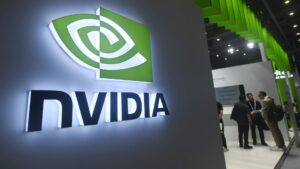—
### Nvidia’s Earnings Report: What Investors Need to Know
As we approach the third-quarter earnings season, all eyes are on Nvidia (NVDA), which has become akin to the Super Bowl of earnings reports. Since early last year, this tech titan has captivated the market with its innovative advances in artificial intelligence (AI) and data center technologies. With the impending earnings report due Wednesday after market close, the anticipation is palpable. At Extreme Investor Network, we’re here to break down what you should be watching for and how you can strategically position your investments.
#### Expectations and Analyst Projections
According to FactSet, analysts predict Nvidia will report earnings of 75 cents per share on revenue of $33.13 billion. A key area of focus will be Nvidia’s new Blackwell GPU, which has reportedly sold out for the next 12 months. While this highlights soaring demand, concerns about supply chain limitations and overheating issues have emerged, creating a complex narrative around the company’s near-term performance.
In the last earnings report, NVDA beat earnings expectations, but only by a slim margin of 5%. This has led to significant volatility in its stock price, which dropped from approximately $130 to $101.50 during August, before rallying back above $130 and nearing $150. Now, with the stock trending in the mid-$140s leading up to the earnings announcement, investors are questioning whether the upcoming report could send us back towards the critical $130 technical level.
#### Portfolio Strategy: Adjustments Ahead of Earnings
Here at Extreme Investor Network, our approach to Nvidia has evolved. We recently increased our position in NVDA within our flagship growth portfolio from 8% to 10%. Additionally, our dividend model allocation has risen from 2.5% to 3.5%. Though Nvidia offers only a modest dividend, it represents over 7% of the S&P 500.
However, prudent investors know the importance of hedging against market uncertainty. In our nimble portfolio, dubbed “Active Opps,” we are preparing for potential volatility by employing a strategic hedge.
#### Tactical Hedging: Navigating Potential Downside
To safeguard against a downturn, we are considering a Nov 22 expiration put debit spread. This strategy entails buying $140 strike puts while simultaneously selling $130 strike puts, currently priced around $2.88 per spread. This means for each spread, you would incur a cost of $288, with a maximum profit potential of $712.
For investors with 500 shares of NVDA wishing to hedge their entire position down to $130, purchasing 5 spreads would amount to a total cost of $1,440, with a maximum profit of $3,560. While this insurance policy may seem costly, we believe the AI boom is just in its infancy, and the premiums could end up as capital losses—insurance that won’t need to be claimed if the company meets its ambitious projections.
#### Looking Ahead: Potential Price Targets
If Nvidia successfully breaks through the critical 100% Fibonacci level at $145.93 and capitalizes on Blackwell’s demand, our analysis suggests that the next target could be around $185.54. With expectations of soaring revenue levels exceeding $40 billion—or even $50 billion—per quarter within the next year, it’s a thrilling landscape for investors.
In summary, Nvidia stands at a crossroads of opportunity and risk. Whether you’re looking to increase your holdings, hedge against potential downturns, or simply gain insights into one of the market’s most pivotal companies, staying informed is essential.
—
As always, remember that this content serves informational purposes only and should not be construed as financial advice. Please consult your financial advisor before making any investment decisions.
—

